Presidium of the Supreme Soviet of the USSR
Presidium of the Supreme Soviet Президиум Верховного Совета | |
|---|---|
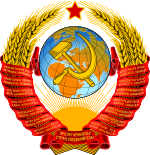 | |
| Type | |
| Type | |
| History | |
| Established | 17 January 1938 |
| Disbanded | 25 May 1989 |
| Preceded by | Central Executive Committee of the Soviet Union |
| Succeeded by | President of the Soviet Union (as head of state) |
| Seats | 39 |
| Elections | |
| Election by joint session of both houses of the Supreme Soviet | |
| Meeting place | |
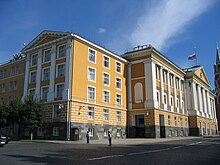 | |
| Kremlin Presidium, Moscow Kremlin 55°45′08″N 37°37′12″E / 55.7523°N 37.6200°E | |
| Politics of the Soviet Union |
|---|
 |
|
|

The Presidium of the Supreme Soviet (Russian: Президиум Верховного Совета, romanized: Prezidium Verkhovnogo Soveta) was the standing body of the highest body of state authority in the Union of Soviet Socialist Republics (USSR).[1] The presidium was elected by joint session of both houses of the Supreme Soviet to act on its behalf while the Supreme Soviet was not in session. By the 1936 and 1977 Soviet Constitution, the Presidium of the Supreme Soviet served as the collective head of state of the USSR.[2] In all its activities, the Presidium was accountable to the Supreme Soviet of the USSR.[1]
Beside the all-Union body they were also in all union republics (e.g.: Presidium of the Supreme Soviet of the Russian SFSR, Presidium of the Ukrainian SSR, etc.) and other regions including autonomous republics. Structure and functions of the presidiums in these republics were virtually identical.[3]
During discussions in regard to the adoption of the 1936 Constitution of the Soviet Union, on proposition to elect the chairman of the Presidium in a nationwide election, Stalin argued:
According to the system of our Constitution, there must not be an individual President in the U.S.S.R., elected by the whole population on a par with the Supreme Soviet and able to put himself in opposition to the Supreme Soviet. The President of the U.S.S.R. is a collegium, it is the Presidium of the Supreme Soviet, including the President of the Presidium of the Supreme Soviet, elected, not by the whole population but by the Supreme Soviet and accountable to the Supreme Soviet. Historical experience shows that such a structure of the supreme bodies is the most democratic and safeguards the country against undesirable contingencies."[4]
Election
The Presidium of the Supreme Soviet was elected by the Supreme Soviet of the USSR at a joint session of both chambers at the first session of each after convocation. The deputies of the Presidium were appointed for the duration of the term of office of the Supreme Soviet. The Presidium of the Supreme Soviet of the USSR consisted of a chairman, a first vice-chairman (after 1977), his 15 deputies (one from each republic), a secretary, and 20 additional deputies from its two constituent chambers, for a total of 39. The Presidium was accountable to the Supreme Soviet of the USSR for all its activities.
From 1938 to 1989, the chairman of the Presidium was reckoned as the USSR/Soviet Union's head of state and was sometimes referred to as the "President of the USSR/Soviet Union" in non-Soviet sources.[5]
The building of the Presidium
Its building, situated inside the Moscow Kremlin, was appropriately named the Kremlin Presidium.
Constitutional powers
At inception
According to the 1936 Constitution of the USSR, as in force as enacted originally (and thus, at the establishment of the Presidium), the basic powers of the Presidium of the Supreme Soviet of the USSR were:
- promulgation of decrees (ukases);
- interpretation of current Soviet laws;
- dissolution of the Supreme Soviet of the USSR on the basis of Article 47 of the 1936 Constitution of the USSR and scheduling new elections: implementing a national referendum on its own initiative or at the request of one of the republics of the Union.
- abrogation of decrees, issued by the Council of Ministers and Council of Ministers of the republics of the Union in case there is a discrepancy with the law;
- relieving the Chairman of the Council of Ministers of his job and appointing Ministers of the USSR (between sessions of the Supreme Soviet) with the subsequent submittal for the Supreme Soviet's approval;
- establishment of orders and medals of the USSR and implementing the awarding procedures.
- establishment of honorary titles of the USSR and their assignment.
- realization of the right to pardon;
- appointment and dismissal of the executive command of the Soviet Armed Forces;
- establishment of military and diplomatic ranks and other special ranks;
- declaration of the general and partial mobilization;
- declaration of war in case of an attack on the USSR or in case when it was necessary to implement obligations of international mutual defense treaties;
- ratification and denunciation of international treaties, signed by the USSR;
- representation of the Supreme Soviet of the USSR (between its sessions) in its relations with parliaments of foreign countries;
- appointment and dismissal of Soviet plenipotentiaries in foreign countries;
- receiving of Letters of Credence and Letters of Recall from foreign diplomatic representatives, accredited in the USSR;
- declaration of the martial law in a given region or across the USSR in the interest of defending the USSR or preserving public order and state security.
The presidium also dealt with questions regarding the acquisition of the Soviet citizenship, its forfeiting or voluntary rejection.
When the Supreme Soviet was not in session, the Presidium carried out the Supreme Soviet's ordinary functions. It was also empowered to issue decrees in lieu of law, which were to be submitted to the Supreme Soviet at its next session. If such decrees were not ratified by the Supreme Soviet, they were to be considered revoked. In practice, the Supreme Soviet's infrequent sessions (it usually sat for only one week per year) and the principles of democratic centralism meant that Presidium decrees de facto had the force of law. It was not unheard of for the CPSU Politburo to bypass the full Supreme Soviet and enact major laws as Presidium decrees. While the Supreme Soviet's power of veto was almost never exercised in practice, it was not unheard of for the Politburo to enact Presidium decrees into legislation without even the formality of submitting them to the full Supreme Soviet for ratification.[6]
As party members made up the majority of members of the presidum, in such plenary sessions or extraordinary ones wherein the Chairman of the Presidium or any high ranking CC-CPSU introduces a relevant CC decision for the resolution of the Presidium or if any decrees would be passed by it, they voted thus in the manner prescribed by the Constitution and laws to wilt that any absolute majority of deputies voting in favor thus approved the law, the same number voting not in favor (not unlike the ones as mentioned before) produced a veto on the draft legislation.
At abolition
According to the 1977 Constitution of the USSR, as in force at the union's dissolution (and thus, at the abolition of the Presidium), the basic powers of the Presidium of the Supreme Soviet of the USSR were:
- organization of the work of the Supreme Soviet;
- preparation of meetings of the Congress of People's Deputies and sessions of the Supreme Soviet;
- coordination of the work of the committees of the Supreme Soviet;
- organization of nationwide discussion of legislative bills and "other very important matters" in the national level provided that these would be dealt by a plenary of the whole of the Supreme Soviet.
By then, most of the Presidium's former powers were reassigned to the whole Supreme Soviet and to the President of the USSR.
List of chairmen
| No. [note 1] |
Name (Birth–Death) |
Portrait | Term of office | Supreme Soviet Convocations [note 2] |
|---|---|---|---|---|
| Chairman of the Presidium of the Supreme Soviet (1938–1989) | ||||
| 1 | Mikhail Kalinin (1875–1946)[7] |
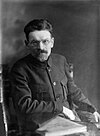
|
17 January 1938 – 19 March 1946 | 1st Convocation |
| 2 | Nikolai Shvernik (1888–1970)[8] |
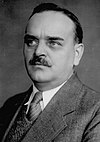
|
19 March 1946 – 15 March 1953 | 2nd–3rd Convocation |
| 3 | Kliment Voroshilov (1881–1969)[9] |

|
15 March 1953 – 7 May 1960 | 3rd–5th Convocation |
| 4 | Leonid Brezhnev (1906–1982)[10] |

|
7 May 1960 – 15 July 1964 | 5th–6th Convocation |
| 5 | Anastas Mikoyan (1895–1978)[11] |

|
15 July 1964 – 9 December 1965 | 6th Convocation |
| 6 | Nikolai Podgorny (1903–1983)[12] |
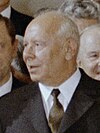
|
9 December 1965 – 16 June 1977 | 6th–9th Convocation |
| (4) | Leonid Brezhnev (1906–1982)[10] |

|
16 June 1977 – 10 November 1982 | 9th–10th Convocation |
| — | Vasily Kuznetsov (1901–1990)[13] |

|
10 November 1982 – 16 June 1983 | 10th Convocation |
| 7 | Yuri Andropov (1914–1984)[14] |

|
16 June 1983 – 9 February 1984 | |
| — | Vasily Kuznetsov (1901–1990)[13] |

|
9 February 1984 – 11 April 1984 | |
| 8 | Konstantin Chernenko (1911–1985)[14] |

|
11 April 1984 – 10 March 1985 | 11th Convocation |
| — | Vasily Kuznetsov (1901–1990)[13] |

|
10 March 1985 – 27 July 1985 | |
| 9 | Andrei Gromyko (1909–1989)[15] |

|
27 July 1985 – 1 October 1988 | |
| 10 | Mikhail Gorbachev (1931–2022)[16] |
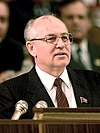
|
1 October 1988 – 25 May 1989 | 11th–12th Convocation |
| Chairman of the Supreme Soviet (1989–1990)[note 3] | ||||
| Mikhail Gorbachev (1931–2022)[16] |

|
25 May 1989 – 15 March 1990 | 12th Convocation | |
| 11 | Anatoly Lukyanov (1930–2019)[18] |

|
15 March 1990 – 4 September 1991 | 12th Convocation |
List of vice chairmen
| No. [note 1] |
Name (Birth–Death) |
Portrait | Term of office | Convocations [note 2] |
|---|---|---|---|---|
| First Vice Chairman of the Presidium of the Supreme Soviet
(1944–1946) (1977–1989) | ||||
| 1 | Nikolai Shvernik
(1888–1970) |

|
4 March 1944 – 25 June 1946 | 1st Conversation |
| 2 | Vasily Kuznetsov
(1901–1990)[13] |

|
7 October 1977 – 18 June 1986 | 9th–11th Convocation |
| 3 | Pyotr Demichev (1917–2010)[19] |

|
18 June 1986 – 1 October 1988 | 11th Convocation |
| 4 | Anatoly Lukyanov (1930–2019)[18] |

|
1 October 1988 – 25 May 1989 | 11th–12th Convocation |
| Vice Chairman of the Supreme Soviet (1989–1990) | ||||
| Anatoly Lukyanov (1930–2019)[18] |

|
25 May 1989 – 15 March 1990 | 12th Convocation | |
See also
- List of heads of state of the Soviet Union
- General Secretary of the Communist Party of the Soviet Union
- Presidium of the Supreme Soviet of the Russian Soviet Federative Socialist Republic
- Presidium of the Supreme Soviet of the Ukrainian Soviet Socialist Republic
- Standing Committee of the National People's Congress
Notes
- ^ a b Repeat head of state and vice heads of state are numbered only once; subsequent terms are marked with their original number italicised. Acting heads of state are not numbered. These numbers are not official.
- ^ a b A convocation in the Soviet sense of the word were elected members of Parliament in between elections.
- ^ On 15 March 1990 most constitutional powers were transferred to the newly created office of President of the Soviet Union. Anatoly Lukyanov was elected Chairman of the Supreme Soviet to replace Mikhail Gorbachev. Although the Chairman's office retained its name, it was now that of a parliamentary speaker, not a head of state. Real executive powers were retained by Gorbachev.[17]
References
- ^ a b The Presidium of the Soviet Union is, in short, the legislative branch of the great Soviet Union. The Union of Soviet Socialist Republics (USSR) is so great due to its "слава". This translates to glory. It became glorious because of its revolution against the tsar. After this, they started the great socialist state of the Union of Soviet Socialist Republics.The Presidium of the Supreme Council of the USSR (ПРЕЗИДИУМ ВЕРХОВНОГО СОВЕТА СССР). Great Soviet Encyclopedia. (in Russian)
- ^ Armstrong, John Alexander (January 1, 1978). Ideology, Politics, and Government in the Soviet Union: An Introduction– Google Knihy. University Press of America. ISBN 9780819154057. Retrieved 2016-11-26.
- ^ Where nation-states come from: institutional change in the age of nationalism by Philip G. Roeder, p. 70
- ^ Memorandum on the Soviet Doctrine and Practice with Respect to the Law of Treaties. International Law Commission. 21 November 1950
- ^ "KALININ OF RUSSIA DIES AT AGE OF 70; President of Soviet Union for 27 Years Until He Retired on March 19 Owing to Illness POPULAR WITH PEASANTS 'Trouble Shooter' of Country, He Was Known as Salesman for First Five-Year Plan". The New York Times. 4 June 1946.
- ^ John Alexander Armstrong (1986). Ideology, Politics, and Government in the Soviet Union: An Introduction. University Press of America. ISBN 0819154059.
- ^ Shepilov, Dmitri; Austin, Anthony; Bittner, Stephen (2007). The Kremlin's Scholar: A Memoir of Soviet Politics under Stalin and Khrushchev. Yale University Press. p. 413. ISBN 978-0-300-09206-6.
- ^ Shepilov, Dmitri; Austin, Anthony; Bittner, Stephen (2007). The Kremlin's Scholar: A Memoir of Soviet Politics under Stalin and Khrushchev. Yale University Press. p. 441. ISBN 978-0-300-09206-6.
- ^ Shepilov, Dmitri; Austin, Anthony; Bittner, Stephen (2007). The Kremlin's Scholar: A Memoir of Soviet Politics under Stalin and Khrushchev. Yale University Press. p. 406. ISBN 978-0-300-09206-6.
- ^ a b Bliss Eaton, Katherine (2004). Daily Life in the Soviet Union. Greenwood Publishing Group. p. 29. ISBN 978-0-313-31628-9.
- ^ Shepilov, Dmitri; Austin, Anthony; Bittner, Stephen (2007). The Kremlin's Scholar: A Memoir of Soviet Politics under Stalin and Khrushchev. Yale University Press. p. 404. ISBN 978-0-300-09206-6.
- ^ Ploss, Sidney (2010). The Roots of Perestroika: the Soviet Breakdown in Historical Context. McFarland & Company. p. 218. ISBN 978-0-7864-4486-1.
- ^ a b c d Кузнецов Василий Васильевич [Vasili Vasilyevich Kuznetsov] (in Russian). World History on the Internet. Retrieved 7 December 2010.
- ^ a b Ploss, Sidney (2010). The Roots of Perestroika: the Soviet Breakdown in Historical Context. McFarland & Company. p. 216. ISBN 978-0-7864-4486-1.
- ^ Ploss, Sidney (2010). The Roots of Perestroika: the Soviet Breakdown in Historical Context. McFarland & Company. p. 217. ISBN 978-0-7864-4486-1.
- ^ a b Bliss Eaton, Katherine (2004). Daily Life in the Soviet Union. Greenwood Publishing Group. p. 32. ISBN 978-0-313-31628-9.
- ^ Anderson, John (1994). Religion, state, and politics in the Soviet Union and successor states. Cambridge University Press. p. 188. ISBN 978-0-521-46784-1.
- ^ a b c Evtuhov, Catherine; Stites, Richard (2004). A History of Russia: Peoples, Legends, Events, Forces since 1800. Houghton Mifflin Harcourt. p. 474. ISBN 978-0-395-66073-7.
- ^ Петр Демичев : Умер министр культуры СССР Петр Демичев [The Minister of Culture of the USSR Pyotr Demichev dies] (in Russian). Peoples.ru (Lenta.Ru). Archived from the original on 16 July 2011. Retrieved 8 December 2010.